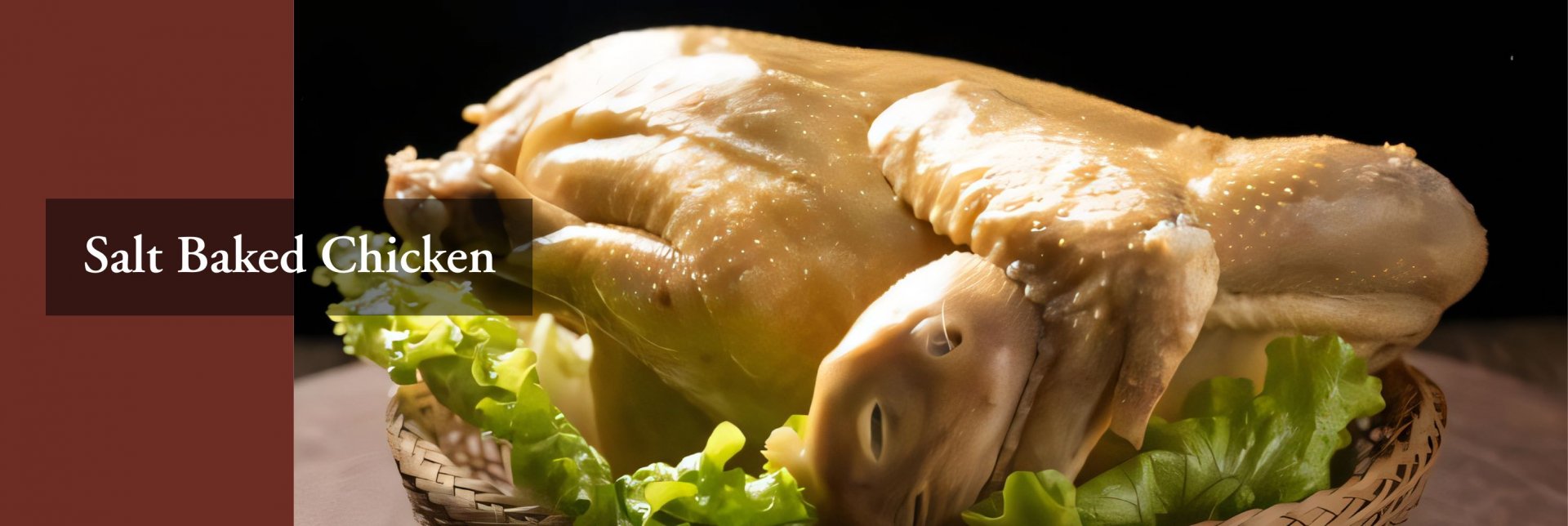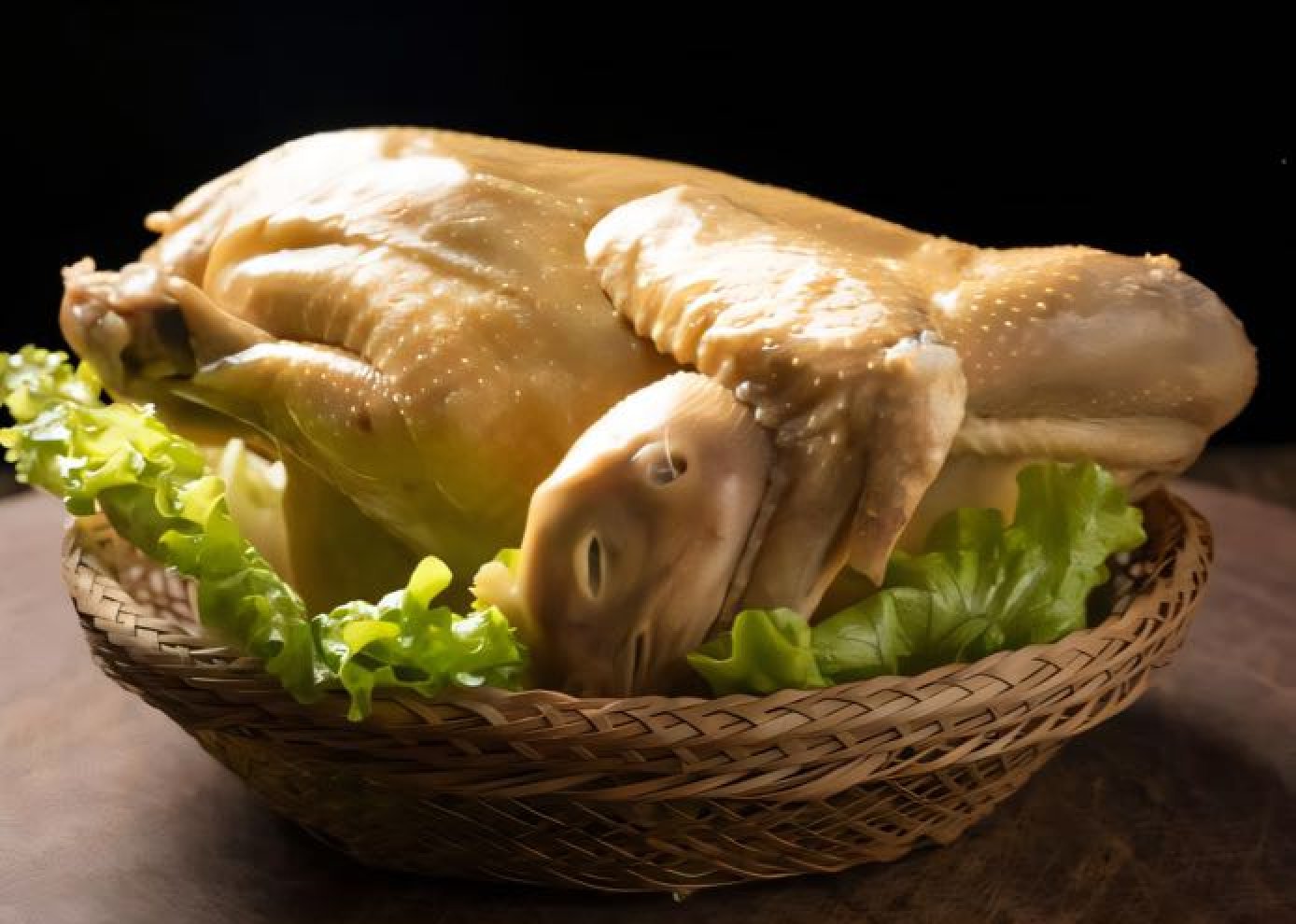Salt Baked Chicken
Salt baked chicken is a dish which can be found in almost all Hakka restaurants worldwide. Nonetheless, the original and authentic version is believed to be the Dongjiang salt baked chicken, which is prepared in a Cantonese cooking style; a style which encompasses flavours and cooking styles from the regions of Guangzhou, Chaozhou, and Dongjiang.

The source of the Dongjiang River is located in the southern part of Jiangxi province, and the Dongjiang River is one of the main tributaries of the Pearl (Zhujiang) River. Since Dongjiang cuisine encompasses the entire eastern Guangdong Hakka region, it is classified under Hakka cuisine. The formation of the Hakka community took place between the late Ming Dynasty and early Qing Dynasty, starting from the southern Jiangxi region, and expanded to western Fujian. It then further expanded into eastern Guangdong, which comprises of a large region with Meizhou as its core.
Guangdong’s Hakka cuisine can be further divided into three subclasses, namely, the “mountain family” (山系), the “water family” (水系), and “miscellaneous Hakka dishes” (散客菜). Dishes from the “mountain family” encompass those originating from the mountainous regions of east Guangdong, including Meizhou, and are known for their salty, fragrant, and oily flavours. On the other hand, Dongjiang cuisine originates from places nearer to rivers and the sea, and hence, it falls under the “water family”.
The Dongjiang salt baked chicken which we are discussing in this essay is the one which originated from Dongjiang Restaurant (东江饭店). Established in 1946, Dongjiang Restaurant was initially named Yunlai Pavilion (云来阁), and was renamed as Ningchang Restaurant (宁昌馆). In 1972, it obtained official approval to be rebranded as “Dongjiang Restaurant”. Back in those days, it was the one and only restaurant that was granted the honours of bearing the name of the locale’s cuisine in their shop name.

The Hakkas have a preference for food with strong flavours. Historically, it is because of the natural geography of the area which they resided in, where they had to exert a lot of strength and effort as they traverse mountainous terrains for their daily labour. Given that these people used to sweat a lot daily, a diet high in salt content was essential. The Hakkas also liked to eat their food warm because they live in mountainous regions where the climate is harsh and cold. Futhermore, since they lived quite a distance from the sea, most of their diet consists of terrestrial animals. There is a famous saying among Dongjiang chefs, “It is not authentic without chicken; if there is no pork it is not tasty; it is not fragrant without duck meat; it is lacking in flavor if there is no goose meat.”
Since ancient times, the Shantou region in Guangdong has always been known for their large salt mines. During the Qing dynasty, an office for the administration of salt was established in the Hakka region of Huizhou in Guangdong, causing it to become a regional distribution centre for salt. From Huizhou, salt was transported to various places via the Dongjiang River. This accounts the many rich salt merchants in Huizhou who often hosted extravagant banquets. During these banquets, there were often many leftover chickens, and hence, the idea of preserving them in salt was conceived. Apart from being a regional distribution centre for salt, another reason why they could come up with such an idea was related to the nomadic lifestyle of the Hakkas. As the Hakkas migrated from one place to another, it was a hassle to take their livestock along with them. Hence, they slaughtered their livestock and preserved them in salt, making it easy to store and to take along. This unique preservation method gave birth to a unique dish – the “Hakka salted chicken”. Over time, chefs in Guangzhou adapted this dish by wrapping chicken in paper and baking them in salt, giving rise to the well-known ancient method salt baked chicken (古法盐焗鸡).


The technique of baking in salt utilizes physical heat conduction. It is a cooking technique that uses salt as a heat transfer medium to cook the raw ingredients. The word “bake” (焗) in Cantonese also means “to grill and lock in the fragrance”. Therefore, salt baking is a cooking technique in which the ingredients are coated and covered entirely in salt before being grilled. After baking, one can feast on the salt baked chicken either by tearing and shredding the chicken using one’s bare hands (this traditional method of enjoying the dish is recommended) or by cutting the chicken up into pieces before serving. Owing to the popularity of Dongjiang Restaurant’s shredded salt baked chicken, the dish has been renamed “Dongjiang salt baked chicken.”

Reference
Book
1. 趙榮光:《中國飲食文化史:東南地區卷》(桃園市:昌明文化,2018)。
2. 周松芳:《嶺南飲食文化》(香港:開明書店,2020)。
Electronic Resources
1. 任崇岳:〈客家民系形成於明代中葉〉,中國社會科學網(https://www.cssn.cn),2019年9月10日發表。(瀏覽日期:2023年2月1日)
All articles/videos are prohibited from reproducing without the permission of the copyright holder.




Welcome to leave a message:
Please Sign In/Sign Up as a member and leave a message